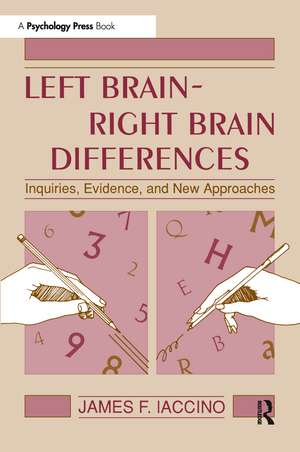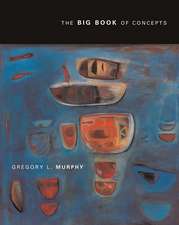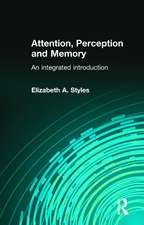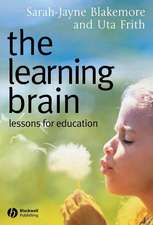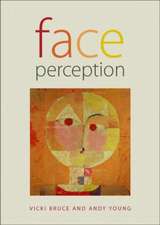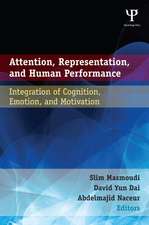Left Brain - Right Brain Differences: Inquiries, Evidence, and New Approaches
Autor James F. Iaccinoen Limba Engleză Paperback – iul 1993
Iaccino begins by explaining basic brain structures and types of cognitive styles assigned to each hemisphere. He then details studies involving various clinical populations -- psychophysiological, split-brain, dyslexic, and psychotic -- to support the claim that the two hemispheres are different, morphologically and functionally speaking. Applying this clinical research to the more normal population, the author uncovers striking cortical variations between the sexes and between the handedness groups, along with developmental changes which occur as a function of time. Finally, he provides a detailed summary of the previous chapters and highlights where asymmetrical research may be headed in the future.
Preț: 699.21 lei
Preț vechi: 852.68 lei
-18% Nou
Puncte Express: 1049
Preț estimativ în valută:
133.80€ • 143.07$ • 111.55£
133.80€ • 143.07$ • 111.55£
Carte tipărită la comandă
Livrare economică 17 aprilie-01 mai
Preluare comenzi: 021 569.72.76
Specificații
ISBN-13: 9780805813418
ISBN-10: 0805813411
Pagini: 296
Dimensiuni: 152 x 229 x 16 mm
Greutate: 0.41 kg
Ediția:New.
Editura: Taylor & Francis
Colecția Psychology Press
Locul publicării:Oxford, United Kingdom
ISBN-10: 0805813411
Pagini: 296
Dimensiuni: 152 x 229 x 16 mm
Greutate: 0.41 kg
Ediția:New.
Editura: Taylor & Francis
Colecția Psychology Press
Locul publicării:Oxford, United Kingdom
Public țintă
ProfessionalCuprins
Contents: Preface. Part I: Introduction to Cerebral Asymmetries. Are Brain Symmetries a Common Misconception? Are Cerebral Asymmetries Unique to the Human Species? Two Brains, Two Cognitive Styles? Part II: Clinical Evidence for Cerebral Asymmetries. What Do Neuropsychological Disorders Reveal About Brain Asymmetries? Are Split-Brain Patients Truly Divided in Cognitive Functioning? Is There Convincing Evidence for Cerebral Asymmetries in the Clinical Pathologies and Developmental Disabilities? Part III: Evidence for Cerebral Asymmetries in Normal Subjects. How Are Asymmetries Studied in the Normal Brain? Are There Gender Differences in Brain Lateralization? Are There Handedness Differences in Brain Lateralization? Are There Developmental Differences in Brain Lateralization? Part IV: New Approaches to and Concluding Comments on Cerebral Asymmetries. What New Techniques Will Be Used in Studying Cerebral Asymmetries?
Recenzii
"...a coherent framework for studying cerebral asymmetry for experimental, clinical, or personal purposes, as well as the latest findings on brain lateralization and new asymmetric models..."
—Behavioral Science
"The writing is...crisp, concise, and appropriate for an audience of advanced undergraduate or early graduate students in psychology....this is an accessible book that would be a valuable supplemental or reference text....particularly recommended for its organization and clarity....a valuable compendium of research related to functional brain asymmetry."
—Contemporary Psychology
"Excepting MRI data, this book contains just about every reference relevant for understanding hemispheric differences up throught the late eighties. It covers visual, auditory, and tactile asymmetries as seen under a wide variety of experimental protocols."
—Philosophical Psychology
"...I found Left Brain-Right Brain Differences to be a well researched, well-written, and concise overview of the field of cerbral asymmetry. This book would be useful (with the caveats noted above) at either the advanced undergraduate or beginning graduate level, in particular as an adjunct text for courses on human neuropsychology or cerbral asymmetries."
—Applied Cognitive Psychology
"...well written and contains a useful summary of the work on cerebral lateralization. It is up to date, and has captured some of the newest trends in neural imaging and handedness, as well as the continuing flow of information on hemispheric differences and their implication for cognitive style and function."
—Stanley Coren
University of British Columbia
"This has been one of my most rewarding learning experiences. Dr. Iaccino has accomplished an impressive job in compiling approximately 1000 references and clearly elucidating and explaining them. The book is a substantial contribution to psychology in general, and our appreciation of the human nervous system's operations in particular."
—M. Allan Cooperstein, Ph.D.
Licensed Psychologist, Clinical Speciality; Board Certified Forensic Examiner
—Behavioral Science
"The writing is...crisp, concise, and appropriate for an audience of advanced undergraduate or early graduate students in psychology....this is an accessible book that would be a valuable supplemental or reference text....particularly recommended for its organization and clarity....a valuable compendium of research related to functional brain asymmetry."
—Contemporary Psychology
"Excepting MRI data, this book contains just about every reference relevant for understanding hemispheric differences up throught the late eighties. It covers visual, auditory, and tactile asymmetries as seen under a wide variety of experimental protocols."
—Philosophical Psychology
"...I found Left Brain-Right Brain Differences to be a well researched, well-written, and concise overview of the field of cerbral asymmetry. This book would be useful (with the caveats noted above) at either the advanced undergraduate or beginning graduate level, in particular as an adjunct text for courses on human neuropsychology or cerbral asymmetries."
—Applied Cognitive Psychology
"...well written and contains a useful summary of the work on cerebral lateralization. It is up to date, and has captured some of the newest trends in neural imaging and handedness, as well as the continuing flow of information on hemispheric differences and their implication for cognitive style and function."
—Stanley Coren
University of British Columbia
"This has been one of my most rewarding learning experiences. Dr. Iaccino has accomplished an impressive job in compiling approximately 1000 references and clearly elucidating and explaining them. The book is a substantial contribution to psychology in general, and our appreciation of the human nervous system's operations in particular."
—M. Allan Cooperstein, Ph.D.
Licensed Psychologist, Clinical Speciality; Board Certified Forensic Examiner
